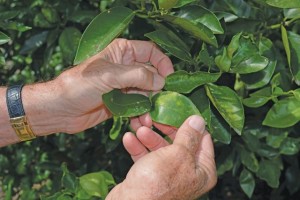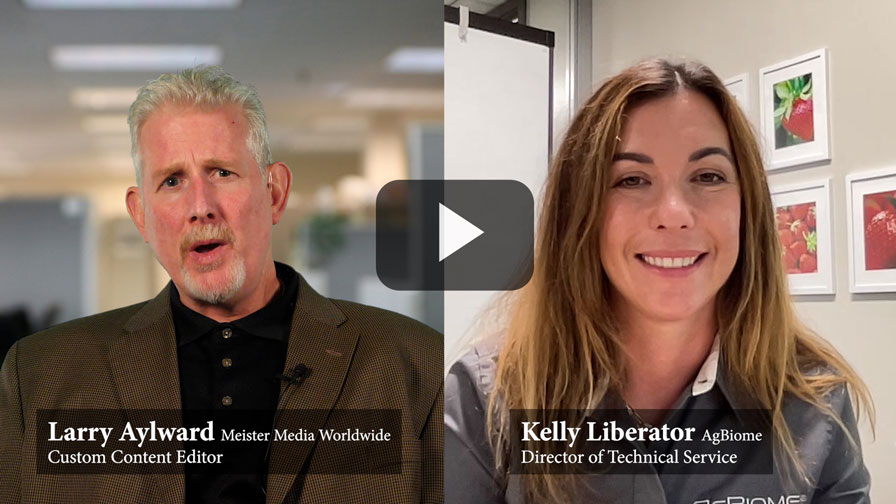Many HLB Finds In California
It’s here, it’s really here. Seven years after Asian citrus psyllid (ACP) arrived in California — or was officially confirmed — there have been numerous finds of Huanglongbing (HLB), a deadly, incurable disease of citrus.
Actually, HLB itself has been in the state for several years, having been detected in 2012 in a lemon/pummelo tree in a residential neighborhood in Hacienda Heights, a suburb of Los Angeles. The tree was removed, and that was it. There have been no other finds until recently.
 In August, the California Department of Food and Agriculture (CDFA) confirmed five additional HLB positive trees near an initial HLB find site just weeks earlier in the San Gabriel area, bringing the total to nine HLB positive trees on seven properties in the region.
In August, the California Department of Food and Agriculture (CDFA) confirmed five additional HLB positive trees near an initial HLB find site just weeks earlier in the San Gabriel area, bringing the total to nine HLB positive trees on seven properties in the region.
The good news, if there can be any in regard to HLB, is the finds were concentrated. The five new trees were found on three properties — one location with three trees and two locations with one tree each.
CDFA survey and treatment crews will remain vigilant in looking for HLB and treating for the Asian citrus psyllid. Industry members are encouraged to follow best management practices, and encourage others to do the same. To check out these BMPs, including a video with tips for citrus industry field workers, go to CitrusInsider.org/resources/.
Another silver lining is that the new finds are in a residential area, about 10 miles east of downtown LA. So far, at least, there have been no finds in commercial production areas. But there is commercial production not that far to the east of the commercial finds, as well as to both the north and south, albeit a little farther away.
Most experts believe it’s just a matter of time before HLB invades commercial areas unless there is a scientific breakthrough. One is the development of genetically engineered trees — (see “GMOs Might Hold The Key”). The citrus industry’s hope is that they can stave off HLB long enough for such a breakthrough. In the meantime, vigilance is required.
Grower Liaisons Are Critical
The battle to save California citrus from ACP/HLB is a collaborative effort and involves, local, county, state, and federal officials, researchers, scientists, and commercial citrus growers. To help citrus industry members stay up to date on efforts to protect citrus, the Citrus Pest & Disease Prevention Program has identified key individuals in each region to be the growers’ point of contact. These are industry veterans of the pest control business. For more about the grower liaisons and how to contact these people who can help you with how best to protect your citrus from the ACP and HLB, check out CitrusInsider.org/grower_liaisons/.
We contacted a few of these regional liaisons, as well as the statewide coordinator, Robert Atkins, for comments on the recent series of HLB finds in the San Gabriel Valley.
Robert Atkins: “These new finds of HLB in San Gabriel remind us of the real threat to our state’s citrus, including commercial, residential, conventional, and organic citrus. We must work together to coordinate our treatments over broad areas and within close time frames if we hope to keep the Asian citrus psyllid in check and halt the spread of this disease.”
Enrico Ferro, San Diego County: “The recent HLB finds are a reminder of how important it is to maintain low population levels of the Asian citrus psyllid. What we do as an industry will determine how fast the HLB bacteria spreads from tree to tree and how many trees will need to be removed as a result. The more proactive we are, the lower the risk. By maintaining low psyllid population levels we can reduce the rate of transmission, and the additional work and costs growers will have to endure if HLB takes hold.”
Curtis Pate, Imperial County: “We are optimistic about the citrus industry in the desert growing region. New acres are being planted at modest rates, leaning heavily to lemons. We expect to continue to battle the Asian citrus psyllid into the foreseeable future. I want to emphasize how important it is for all growers to band together and do what they can now to protect our citrus.”
SIDEBAR: GMOs Might Hold The Key
Editor’s Note: The following information was compiled from articles written by the editor of Florida Grower® magazine, Frank Giles.
Many experts believe that the best and perhaps only long-term answer to truly defeating Huanglongbing (HLB) in citrus is developing a tree through the use of genetic modification.
In a landmark step in the fight against the disease, a few months ago the EPA approved the application of a Florida grower, Southern Gardens Citrus (SGC) for an Experimental Use Permit (EUP) for testing genetically modified citrus trees under the Federal Insecticide, Fungicide, and Rodenticide Act. SGC, headquartered in Hendry County, FL, is one of the largest citrus producers in the state. All three of its Southwest Florida groves are infected with HLB.
Over the last several years, SGC has worked to find an efficient and effective solution to this very serious disease. The EUP authorizes large-scale tests of citrus plants containing a protein derived from spinach, which SGC has developed through a research program with Texas A&M University.
Consistent with the conditions established by the EPA, SGC may now move forward with field tests to evaluate the efficacy of the spinach protein against HLB in citrus plant tissues and continue generating the environmental, health, and safety data that are required under federal law to support a fully registered product for commercial use.
On the basis of SGC’s related petition, EPA also concluded that residues of the spinach protein in citrus are safe for the public, and established a temporary allowance (known as a tolerance exemption) to cover this.
Ricke Kress, SGC president, states that “since this disease was first detected in the company’s groves in 2005, the immediate decision was to become as proactive as possible to learn about the disease and at the same time, develop methods and procedures to deal with the disease on a day-to-day basis. The company directed a research focus toward spinach because it is already safely consumed daily and should be more favorably received by consumers. It is important to state that as all U.S. regulatory controlled field trials and evaluations are ongoing, there is no citrus fruit or juice product from the tests in the commercial product market today.”
Kress notes that a final solution to eliminating this disease may still take some years, but the latest EPA action and continuation of all research projects are major steps in the right direction.
The spinach research was conducted by Erik Mirkov, a professor of plant pathology and microbiology at Texas A&M University, who isolated the gene he says encodes a protein that has broad spectrum antimicrobial activity against bacterial and fungal plant pathogens.
“The protein from spinach belongs to a large class of antimicrobial proteins known as defensins,” Mirkov says. “Defensins are ubiquitous in nature and are in plants, insects, and animals (including humans). They bind to the cell wall of the HLB bacterium and make holes in the cell wall, and the bacteria breaks apart and dies.”
Mirkov developed the trees in his lab, and with the cooperation of the Florida Department of Agriculture & Consumer Services, brought the material to Southern Gardens for greenhouse testing and ultimately field testing.
“We put the first genetically modified trees in the ground in 2009 in controlled field trials,” Kress says. “All of these trees are planted and regulated as part of the federal government approval program. You don’t step out with any of this technology without concurrence of the federal and state agencies involved.”
Six generations of transgenic trees have been developed since 2009. With each generation, researchers refine the gene’s placement in the tree’s DNA to improve performance against HLB.
“We have a tree from our first generation that bore fruit this year,” Kress says. “Compared to control trees that are either stunted or dead, this tree is growing. It is showing a little infection, but it is growing. It is tolerant to HLB. It is a start.”
OPINION: Lessons We Can Learn From HLB In Florida

Frank Giles
As editor of Florida Grower magazine, I’ve been asked to share a few observations from our state about the progression of Huanglongbing (HLB) since its official confirmation in 2005. Having been editor since 2007, I’ve been witness to much of the disease’s official presence in our state. Of course, most agree it was here well before 2005.
The endemic spread of HLB in Florida and the resulting falling production numbers, particularly in the past few seasons, should give California growers pause. I believe your mandatory quarantines and spray programs for the Asian citrus psyllid and tree removal when HLB is found is the right way to go.
In Florida, a perfect storm of events made this “recommended” approach impractical for the citrus industry. Right as HLB was confirmed, the state was raked by hurricanes in 2004 and 2005. This spread the psyllid far and wide. It also created perfect conditions in the trees — flushing with new growth — to attract psyllids to spread the disease. By the time growers’ heads stopped spinning from hurricane clean-up and a failed citrus canker eradication effort, HLB was getting well entrenched in our groves.
So, imagine the prospect of following the recommendation of removing infected trees when more than 30% of your grove is already infected on its first inspection. For some, the removal of inoculum would have meant going out of business, so it didn’t happen in a lot of places.
In the case of California, hopefully the initial finds will remain isolated and tree removal can help you keep ahead of the disease’s spread or at least give a little more time than we have had in Florida. We have learned every action and step taken in response to this endemic matters.
If you have not come to Florida to tour groves, you should. It will give you a better feel for how the disease has spread and its impact on groves. In addition, you can see some of the ingenious production practices growers have developed to hang on while science seeks longer term solutions.
Finally, I’d suggest you support funding HLB research. This a spreading disease, and I believe efforts to hold it at bay can only last for so long. That means it must be defeated or citrus growers must have an economically viable way to live with the disease. We have neither yet, so a no-holds barred research effort must be aggressively funded until we do.









